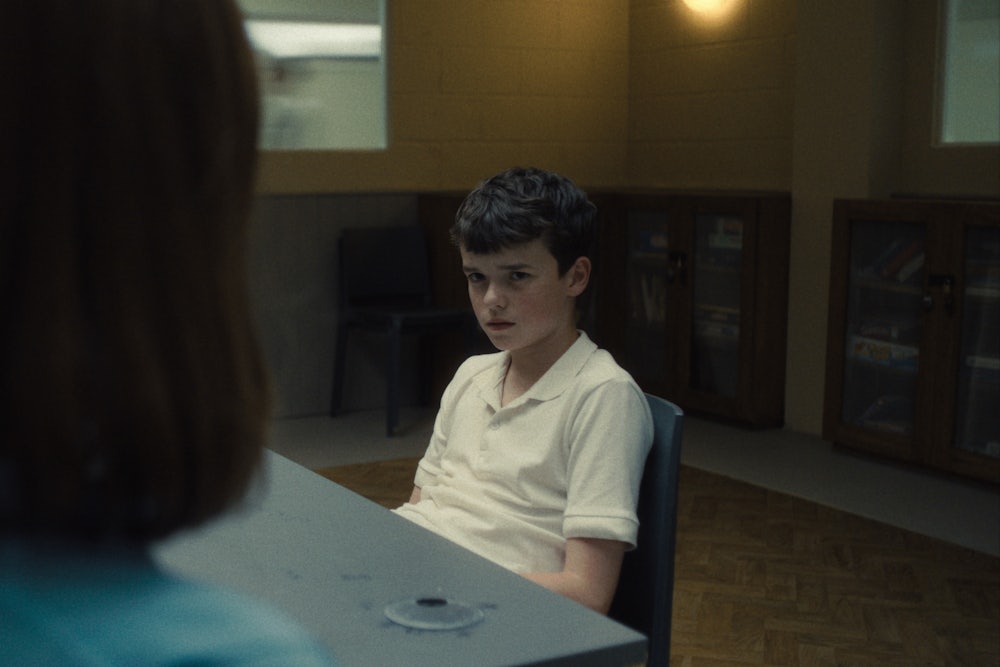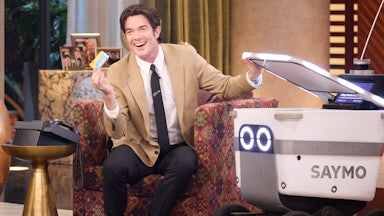There sure are a lot of TVs in the second episode of Netflix’s terrifying and terrified miniseries Adolescence. A teen girl, Katie, has been stabbed to death in a parking lot next to a playground. It’s not a mystery. The police know who did it. The murderer is Jamie, a diminutive, sweet-faced 13-year-old boy from a good family, and the cops have him in custody. What the police don’t know is why. After a kinetic first episode that follows Jamie’s arrest and processing and that ends with us watching, alongside his baffled father (Stephen Graham), a crisp video of Jamie committing the heinous act, the entire second episode takes place at school, on a quest for answers.
Our two detectives, Bascombe (Ashley Walters) and Frank (Faye Marsay), have traveled to the school Jamie and Katie shared in pursuit of a motive, or, failing that, at least a murder weapon. Why would somebody have done this? What’s the matter with this boy? Led on a circuitous tour by a rattled teacher, the two inspectors seemingly probe every nook and cranny of the school’s labyrinthine indoor-outdoor campus.
It’s worth noting at this point that every episode of Adolescence is shot in one long, unbroken take, offering us a far more exhaustive, and seemingly more rigorous, visual account of these events than we might expect. So while the first episode is a frenetic freak-out, the second episode is a swirling, dizzying breakdown. We see a playground fight between two kids, we watch numerous classrooms descend into mayhem, we see tense, traumatized interviews with schoolkids, as well as prickly, combative ones, we see bullied and bullying students, we learn these teenagers’ horrific social media customs, we get a fire drill, we get an athletic foot chase, and we get a warm moment of reconciliation between Bascombe and his own son, who happens to also be a student at the school. We get, in general, a nightmarish picture of the environment contemporary kids enter when they go to school in the morning.
But the most telling detail—about the show, not necessarily the world it represents—appears almost exclusively in the background during one particularly long walking sequence. As the detectives walk through the school halls, in what appears to be every single classroom they pass, there is a television on. This fact is referenced in dialogue a few times. We hear students ask for “video,” and we hear teachers admonish students to pay attention to it. But the aggregate impact of all those glowing machines—accumulated and emphasized by way of the episode’s uncut oner—is profound. It’s also a little too much. As a rule, the show is committed to a kind of gliding Steadicam kitchen-sink realism, to a truthful accounting of contemporary society, to a probing investigation of the curdled minds of the young, to an actionable critique of society, but the visual italicization of this detail rings false in its cartoonish extremity. It’s the kind of hallucinatory running gag we might expect from a dystopian satire like Black Mirror. But this is Adolescence’s agitprop methodology: The show turns social problems into spectacles so that we grown-ups can see them. It’s an effective technique as well as a compromising one.
The parents, they’re scared. And this fact—not necessarily the depth of the crisis among young boys or the pathological overuse of screens—is ultimately what Adolescence is about. The show has been a tremendous commercial and critical hit for Netflix. It’s already become one of the most popular original, English-language shows in the streamer’s history—such that Netflix is apparently considering the idea of a second season—and it has been praised up and down on both sides of the Atlantic. Alan Sepinwall in Rolling Stone called it “an early contender for the best thing … you’ll see on the small screen this year,” and Lucy Mangan in The Guardian called it “the closest thing to TV perfection in decades.” But it hasn’t become this kind of smash just because of its well-executed oners. In an illuminating recent piece in The Cut, Kathryn Jezer-Morton surveyed a number of adults who see reflected in Adolescence’s sickening long takes both their experience of the children they know and their fears about the children they know. Parents and educators alike testified to the profoundly uncanny familiarity of the world Adolescence puts on-screen. The show’s “record-breaking popularity,” Jezer-Morton writes, has less to do with its quality than with “a gut feeling shared by parents of teens: Something’s seriously off.”
In this way, the show converges with a pair of other flashpoint cultural texts that have recently studied, and proposed discrete solutions for, this particular gut feeling. Richard Reeves’s 2022 book Of Boys and Men: Why the Modern Male is Struggling, Why It Matters, and What to Do About It describes how, as girls’ educational outcomes have markedly improved over the past number of decades, boys’ educational outcomes have actually cratered. He suggests solutions as sweepingly structural as universal pre-K3 and pre-K4 and solutions as makeshift and patchy as redshirting boys at kindergarten by holding them back a year. Likewise, Jonathan Haidt’s 2024 book, The Anxious Generation, argues that the cause of everything from worsening mental health to increasing loneliness among young people is the ubiquity of smart phones. Haidt’s policy solution is a straightforward ban on phones in schools. These books have resonated with readers because they both express and explain the feeling that something’s seriously off with the kids.
Perhaps predictably, Adolescence itself has jump-started a campaign, led by series co-creator Jack Thorne, for a social media ban in the U.K. for everyone under 16. But, as even Thorne has admitted, the show itself does not land on social media as the sole culprit, nor does it really offer a strenuous argument in any one direction. But technology is clearly the vector through which the series understands the problem. In the school episode, there’s a scene in which the detective, Bascombe, is educated in social media lingo by his teenage son. Bascombe is in possession of Instagram posts from Jamie’s account that appear to show Katie replying with positive, even amorous, emojis to the boy’s photos. He’s thus been asking around about a possible relationship between the two. Bascombe’s son Adam sets him straight: The emojis would be legible to any teen, especially Jamie, as teasing, not positive attention. She’s not saying she likes his picture; she’s calling him an incel. Katie was bullying Jamie online. Even this, though, is a bit of a red herring, as we later learn that Jamie had drawn Katie’s attention in the first place by propositioning her in a particularly grotesque way. The other detective, Frank, later mentions “that Andrew Tate shite,” but the show doesn’t delve into the content of the Manosphere so much as throw it out there and move on.
For Adolescence, however, the point of this interaction isn’t Katie’s cyberbullying or Jamie’s YouTube watchlist. It’s Bascombe’s ignorance. The scariest thing, scarier even than motive or misogyny, is the not knowing. The problem of the phones, in the show’s accounting, is that teens speak a language within them that we don’t understand, and they do so outside of our knowledge. While Thorne’s crusade and Haidt’s recent notoriety have led viewers to organize around phones, Adolescence evokes a generalized panic, not a problem with an easily identified cause. The show is not all that interested in external factors. But neither is it all that interested in internal factors, so spooked as it is by the idea that, after all this investigation, Jamie is ultimately, tragically, frighteningly unknowable.
All the same, the show’s lauded third episode nominally focuses on the young boy and what on earth is going on with him, taking place almost entirely in a secure room at the detention center where Jamie is being held. A forensic psychologist named Briony Ariston (Erin Doherty) is there to assess Jamie’s understanding of his crime prior to his trial. Owen Cooper, who plays Jamie, oscillates with petulant ease between the charming little bloke everyone presumed him to be and the hysterical rage monster he sometimes becomes. At times, Jamie behaves like a confused child, his adolescent mind curdled by exposure to professional misogynist influencers. At other times, as he lashes out, attempts to physically intimidate Ariston, and bangs against the walls of the room in a tantrum, this seems like the portrait of a sociopath. Was this kid poisoned by the internet, or was he just rotten and nobody noticed?
The show doesn’t offer answers to this question because it doesn’t have any. In talking about his research methodology for writing the show, Thorne has described creating fake social media accounts and immersing himself in the Manosphere. As a covert anthropologist, he watched the videos, he read the tween blogs, he lurked in the forums. Jamie’s raving monologues might easily have come from the mouths of Thorne’s blogroll, from the comment threads below all that Andrew Tate shite. But the show mistakes these performances for revelations. Adolescence offers neither deep insight into these kids’ behavior nor a rigorous and systematic description of the world they inhabit. The show, of course, is under no obligation to solve the problem it depicts. But the problem it depicts is not actually the problem with Jamie. It is a crisis of flailing parental panic.
It is this, I suspect, that parents recognize most acutely when they watch. It can be edifying to see one’s own fear painted on-screen with such intimately textured strokes. Adolescence’s formal showiness, its unrelenting long takes and tight close-ups, might seem to align with the confusion and rage duking it out inside the mind of our titular adolescent. But this paranoid style actually more reflects the searching, inchoate dread of the adults. Their inability to find legible answers to their questions, their unblinking quest for narrative stability, their fear and anger and remorse. The show, then, doesn’t necessarily illuminate or even inquire too deeply into the mystery box of a boy’s brain so much as it mirrors back to us the spectacle of our own terror.
The kids are not all right. They’re also not all there. It turns out that the third episode’s gesture toward interest in the internal life of this child is a head fake. It ends as Jamie exits the interrogation room and we sit for a few long moments with the hyperventilating adult psychologist who remains. The critic Doreen St. Felix described this ending as “earnest and artificial,” and I think that’s precisely it. I believe the psychologist’s fear, I believe her despair, but the real story already left the room.
If this scene doesn’t betray the show’s true subject, the final episode certainly does. It focuses on Jamie’s father, Eddie (Stephen Graham), trying months later to enjoy his fiftieth birthday with his family despite the burden of his own guilt, confusion, and complicity. Leaving Jamie behind, the show chooses to end with the parents, away from the realms of desperate youth and bloodthirsty babies. Graham is, as you may have heard, extraordinary—his muscle-bound body tensed like a heart attack, his fluting voice strained past its breaking point. There are several haunting scenes in this episode, attempts to regain normalcy, foolish attempts to forget. But the most haunting thing about it is who’s absent.
There’s no episode, for instance, about Jade, Katie’s best friend, whose complicated home life we hear her tell a sympathetic teacher about only in the second episode. There’s no episode about Lisa, Jamie’s sister, who tells her parents about the effect that Jamie’s crime has had on her own life as a teenage girl but who is only featured here managing her father’s unraveling. There’s no episode about Tommy or Ryan, Jamie’s friends who seem alternately horrified and proud of their friend’s misdeed. There’s no episode about Adam Bascombe, a bullied young boy—with a phone!—who has somehow not become a bully or a murderer. Instead we have a final episode, a final statement, that plays like an after-school special made by the Danish avant-garde filmmaking group Dogme 95. Graham delivers a bravura performance, undermined only by the didacticism of his final scenes. But the show’s ultimate reveal is that its only real subject has been the psychic lives of adults.
I’m scared. I am also a parent, and I am also scared. About all the regular stuff, but also about the phones and the schools and the boys and the girls and the Manosphere. Parents have always been afraid of and for their children, especially when they disappear into spaces where we can’t see them, whether those spaces are their bedrooms or their classrooms or their devices or even just the recesses of their own minds. Like Eddie, like Ariston, like Haidt and Reeves and Thorne and Graham, I’m scared. But my fear is neither useful nor all that interesting. If Adolescence starts a conversation, I’ll be happy it did; if it is the conversation, I think we’re all in big trouble.










